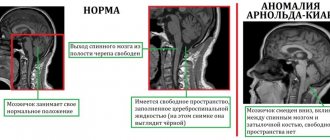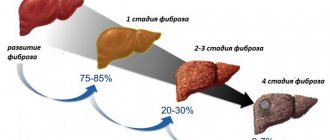Premenstrual syndrome (PMS) is a complex of psychological and physical manifestations that occur some period of time before the onset of menstruation.
But you can feel the same signs when pregnancy occurs, precisely at the moment the egg enters the uterine cavity. In such cases, it is difficult to determine the difference: PMS or pregnancy, but still some symptoms are distinctive.
Changes inherent in PMS and pregnancy:
During the premenstrual period and during pregnancy, changes occur in your condition. Symptoms of PMS and pregnancy:.
- change in eating behavior, the amount of food consumed increases, a constant desire to eat;
- abnormalities in the digestive system (nausea, heartburn, bloating);
- increase in breast size, increased sensitivity;
- the appearance of fatigue;
- cramps in the lower abdomen (read the article: Abdominal pain is a sign of pregnancy>>>);
- pain in the back;
- quick change of mood.
Why PMS is not a “female whim”, but a disease that needs to be treated (and which not everyone has)
We constantly talk about how ashamed we are when we yell and get annoyed with our children, but if you, for example, are sick, then maintaining composure is doubly difficult. Just imagine, you are sick with the flu, children are jumping on your head? Most likely, the partner understands that the flu is a serious illness and will try to take care of the children. With PMS, the story is completely different. Premenstrual syndrome is usually perceived as a kind of “female hysteria”, some kind of “woman’s things”. “Are you having these days?” - a classic sexist argument in any conflict between a man and a woman. In fact, PMS is not delirium or whims at all, but a serious disease that requires intervention and treatment. Yes - it is very difficult for a woman suffering from PMS to be understanding and calm because she does not feel well. Psychiatrist Sergei Kistenev told in his blog why PMS is serious and what to do about it.
Modern ideas and tactics
Many women of reproductive age experience irritability, weakness, outbursts of aggression or depression about once a month. According to some reports, up to 40% of women experience some kind of inconvenience during the second phase of the cycle. Some of them have accepted it and consider it their “highlight”, but most still feel significant discomfort. As you may have guessed, we will talk about PMS.
Premenstrual syndrome (PMS) is a real disorder that needs to be diagnosed and treated, and not hushed up and waited for menopause as a cure.
Premenstrual syndrome is a complex psychoendocrine disorder that affects a woman’s emotional and physical well-being. In a broad sense, PMS is a combination of emotional, behavioral and somatic disorders that begin in the luteal (premenstrual) phase of the menstrual cycle and end with the onset of menstruation. Premenstrual dysphoric syndrome (PMSD) is a rather unpleasant course - a variant of severe PMS, in which mood and behavior disorders can turn into aggression.
How do you know if you have PMS?
- First of all, if you've never thought about it, you probably haven't.
- Secondly, you can turn to the variants of the course of PMS.
Clinical classification of PMS
The clinical classification according to the forms of premenstrual syndrome, which quite fully describes the possible variants of clinical manifestations, is given below.
Neuropsychic form (dysphoric)
The clinic is dominated by mood disorders, aggressiveness, irritability, depression, apathy, and tearfulness.
Edema form
Characterized by the formation of edema, fluid retention, bloating, and swelling of the mammary glands.
Cephalgic form
Patients complain of headaches, increased sensitivity to light and sound, depressed mood, headache, which is sometimes accompanied by nausea and vomiting.
Crisis form
Reminds me of panic attacks. A woman may experience acute fear, which is accompanied by sweating, tachycardia, and chest pain.
The frequency of occurrence of these forms depends on age, for example, at 16-20 years old and at 25-34 years old, as a rule, the neuropsychic (dysphoric) form occurs, and at 20-24 years old - the edematous form. There is no clear justification for this age distribution, but statistically the edematous form is more common in this age group: 20-24 years. Crisis and cephalgic forms are less common and their origin may be related to stress.
If you have the symptoms described above and they interfere with your activity in the days before menstruation, this is a reason to consult a gynecologist.
I would like to specifically focus on premenstrual dysphoric syndrome (the most severe form of PMS). Often a woman attributes PMDS to a feature of her character. This is quite paradoxical, because objectively she suffers from this. I want to give the most reliable diagnostic criteria for PMDS, so that any woman who discovers them in herself will realize that she needs to seek help.
Clinical criteria for PMDS according to DSM (Diagnostic and Statistical Manual of mental disorders):
(A) During the past year, most menstrual cycles (at least three) have experienced five (or more) of the following symptoms, with one of them being one of the first four; symptoms persist during the last week of the luteal phase, disappear a few days after the onset of menstruation, and are absent for a week after menstruation:
- sadness, hopelessness, self-judgment (depreciation of self-worth);
- tension, anxiety;
- severe mood lability with intermittent bouts of tearfulness;
- constant irritability, anger, conflict;
- decreased interest in usual activities, which may be associated with alienation from social connections;
- difficulty concentrating;
- fatigue, lack of energy, drowsiness;
- changes in appetite with overeating or the need for specific (sometimes inedible) food;
- hypersomnia or insomnia (insomnia);
- subjective feeling of being overwhelmed or lacking control;
- somatic symptoms (tension or pain in the mammary glands, a feeling of body swelling or weight gain, headaches, joint and muscle pain).
(B) These symptoms prevent:
- professional activity,
- learning, as well as usual social activities,
- interpersonal relationships.
(B) The symptoms are not the result of another disorder, such as major depressive disorder, panic disorder, dysthymic disorder, or personality disorder (although they may overlap with any other disorder).
Dysphoria and increased fatigue in the premenstrual period may be associated with exacerbation of a somatic disease (endocrine disorders, oncological pathology, systemic lupus erythematosus, anemia, endometriosis, various infections). Differential diagnosis in these cases is facilitated by (1) medical history, as well as data from (2) laboratory tests and (3) physical examination.
The basis for diagnosis is the cyclical nature of symptoms. For a definitive diagnosis of PMDS, criteria A, B and C (simultaneously) must be observed during two menstrual cycles.
Treatment or who to go to
Premenstrual syndrome is treated by a gynecologist, but if the course becomes more complicated and mood and behavior disorders appear, you should consult a psychiatrist.
Treatment methods:
- Non-drug method: Physical activity, normalization of work schedule, sex, rest.
- This method is effective only at the initial stage and you should not rely on it; if complaints do not go away within two cycles, it is better to immediately visit a doctor.
- Hormonal treatment method: the gold standard for treating PMS, prescribed by a gynecologist.
- Oral contraceptive (OC) therapy is used to suppress ovulation.
- Antidepressants: this group of drugs is used if PMS symptoms have not been reduced during OC therapy for two full cycles.
- The second option is if a woman does not want to use OCs or there are contraindications for their use. To correctly prescribe antidepressants, you need to consult a psychiatrist.
- Other methods: tranquilizers, non-steroidal anti-inflammatory drugs, diuretics. They are used only symptomatically and cannot replace the main method of therapy!!!
Debunking myths
The development of PMS and PMDS is NOT affected by:
- Family status;
- Amount of children;
- Irregular sexual intercourse;
- Early or late age of onset of menstruation;
- Cycle length;
- Use of OCs or other hormonal methods of contraception (contraceptives can be a method of treating PMS and PMDS, but do not provoke their occurrence).
In fact, risk factors for the development of PMS and PMDS are:
- stress,
- obesity (BMI over 30),
- diabetes,
- asthma,
- sexual infections.
Depression and anxiety (which occurs regardless of the phase of the cycle. Symptoms increase before menstruation). COCs can increase depressive symptoms, so before prescribing you need to conduct at least a screening test for depression. If you have depression, it is better to discuss the tactics of prescribing COCs with a psychiatrist.
In conclusion, I would like to say: dear women, be healthy. But if you suddenly find yourself with the condition described above, or one of your loved ones suffers from it, or perhaps is being treated unsuccessfully with folk remedies (mint, valerian, celery), there is no need to wait for a miracle and suffer, seek medical help.
Sources:
1 Usman S, Indusekhar R, and O'Brien S. Hormonal management of premenstrual syndrome. Best Pr. Res Clin Obs. Gynaecol 2008, 22: 251–60.
2 Vos T, Flaxman AD, Naghavi M et al. Years lived with disability (YLDs) for 1160 sequelae of 289 diseases and injuries 1990GÇô2010: a systematic analysis for the Global Burden of Disease Study 2010. Lancet, 2012, 380(9859): 2163–2196
3 Yureneva S.V., Prilepskaya V.N., Ledina A.V. Premenstrual syndrome and premenstrual dysphoric disorder.
4 Guide to outpatient care in obstetrics and gynecology, 3rd, revised. V. N. Serov, G. T. Sukhikh, V. N. Prilepskaya, V. E. Radzinsky. M.: GEOTAR-Media, 2020: 895–907.
4 Schiller CE, Johnson SL, Abate AC, Schmidt PJ, and Rubinow DR. Reproductive Steroid Regulation of Mood and Behavior. Compr. Physiol., 2020 July, 6: 1135–1160.
5 Power RF, Mani SK, Codina J, Conneely OM, O'Malley BW. Dopaminergic and ligand-independent activation of steroid hormone receptors. Science, 1991, 254(5038): 1636–1639.
In order not to miss anything useful and interesting about children's entertainment, development and psychology, subscribe to Telegram
Differences in women's conditions
When the above changes occur, the question arises: how to distinguish PMS from pregnancy. Still, there are some signs of PMS and pregnancy that have differences in physiological changes:
- Relationship with food;
- With PMS, the desire for more food consumption increases;
- After conception, there is a craving for new tastes and foods;
- There may be a special desire for salty foods and unusual foods. This phenomenon is due to the body’s desire to compensate for the lack of vitamins and microelements;
- There may be an aversion to food associated with the onset of toxicosis, which does not occur with PMS (article on the topic: Nausea is the first sign of pregnancy>>>).
- With PMS, constipation or diarrhea is possible; constipation is inherent in pregnancy (see article Constipation during pregnancy>>>);
- Breast enlargement occurs due to changes in hormonal balance. It is impossible to distinguish by this feature, but this can be done by the duration of the phenomenon;
- With PMS, breast size changes for several days, after which it returns to its usual state;
- During pregnancy, this increase becomes permanent. Therefore, if the breasts do not return to their usual state, then such an increase is most likely associated with pregnancy;
- The enlargement is accompanied by painful sensitivity, a symptom common to both conditions.
- Fatigue occurs during PMS and pregnancy, due to an increase in the amount of progesterone. With the first days of menstruation, the feeling of fatigue goes away. In the case of early pregnancy, fatigue is felt periodically.
Important! You should not attribute the feeling of fatigue to conception, because it is often a sign of other diseases. If you have chronic fatigue, you need to pay attention to your diet and consult a doctor.
- The occurrence of pain in the lower abdomen;
- With PMS, the lining inside the uterus begins to shed, causing pain. Such pains are characterized by more severe spasms, and everything is individual for each woman. Some have stronger cramps, others have weaker ones;
- In the early stages after conception, the appearance of pain is also possible. But the nature of the pain is milder and short-term (see the article Pulling in the lower abdomen - a sign of pregnancy>>>).
- Nagging pain in the back;
They are typical specifically for PMS, because such pain during pregnancy mainly occurs closer to the second trimester, when the growing fetus begins to put pressure on the spine and with increased load on the support column.
- Changes in a woman’s mood occur under the influence of hormonal changes. Although this phenomenon is inherent in both conditions, there are still differences.
- With PMS, a woman experiences more negative emotions: vulnerability, irritability, resentment, uncertainty, anger;
- With the onset of menstruation, mood stability returns, the intensity of sensual emotions subsides as hormonal balance is restored;
- During pregnancy, there is a change in pronounced positive and negative emotions. Irritability and moodiness last a long time;
Causes of PMS
Since the true causes of premenstrual tension syndrome have not been determined, only provoking factors can be named.
Risk factors:
- instrumental gynecological interventions - childbirth, abortion, installation of an IUD;
- unbalanced nutrition, diets, fasting;
- irregular sex life, lack of sex life in mature women;
- reduced physical activity, sedentary lifestyle;
- traumatic brain injuries;
- taking hormonal medications, psychotropic substances, drugs;
- bad habits – smoking, drinking alcohol;
- infections and inflammatory diseases of the genitourinary system;
- stress and depression;
- increased intellectual load;
- chronic fatigue and lack of sleep;
- changes in carbohydrate metabolism;
- endocrine disorders;
- lack of serotonin;
- avitaminosis.
According to statistics, PMS often affects young girls of reproductive age. For many, after the birth of a child, the severity of the syndrome decreases.
Changes inherent in early pregnancy
It is impossible to say with 100% certainty what differences there are between PMS and pregnancy.
In the early stages of pregnancy, the body gets used to the new state, and a kind of fitting of the fetus to your body occurs.
If any errors or failures occur during conception, your body will get rid of the fetus.
This mechanism helps to bear only a healthy child.
How can you distinguish PMS from pregnancy before a delay?
Let's look at the situation and your feelings more broadly. We are trying to find symptoms inherent in pregnancy. What could it be?
- Increased frequency of urination;
This manifestation is characteristic of both late and early stages. It is caused by changes in metabolic processes and hormonal balance, in particular, the production of the hormone human chorionic gonadotropin.
Under the influence of hormones, the tone of the bladder walls changes, which causes an increased urge to urinate.
- Toxicosis is the body’s reaction from pregnancy to delay, distinguishing pregnancy from PMS;
Its appearance is possible immediately after the attachment of the egg. After the first week, you may already notice signs of toxicosis (read: Toxicosis in early pregnancy>>>). With PMS, this phenomenon is excluded.
With PMS or pregnancy, differences of this type are significant.
- If such discharge appears between periods, this may be a sign of pregnancy;
- They differ from menstrual discharge in volume and color. They have a more scanty, spotting character and a longer period (from a week to two weeks);
- They are similar to the discharge of the first or last days of menstruation;
- The color also differs: it can be pale pink or brownish, in contrast to the scarlet discharge during menstruation.
- The appearance of dizziness. It is caused by changes in hormonal balance and blood volume. As a rule, it does not appear before the delay, but is typical in the third and fourth weeks of conception;
- Feeling hungry for more than a few days;
- Increased sensitivity to odors;
- The occurrence of a change in habitual breathing. The appearance of shortness of breath;
- The appearance of an unusual taste in the mouth. The phenomenon is not common, but possible.
Ambiguity in the appearance of symptoms
Diagnosis in the early stages of pregnancy is very difficult. Pronounced symptoms of pregnancy become visible after a delay, and those signs that appear before the onset of menstruation are extremely ambiguous.
- Symptoms of PMS occur several weeks before the onset of menstruation and disappear when they occur. Some symptoms that caused pregnancy do not go away;
- Also, all of the above indicators do not appear as a complex; it is quite possible that only a few will appear.
Swelling due to PMS
Edema worries every second woman who suffers from premenstrual tension syndrome. One morning a woman wakes up with bags under her eyes, her eyelids are swollen, and her feet cannot fit into her usual shoes. The culprit for this is the same hormone of the second phase - progesterone. Swelling due to PMS is clearly visible on the scale. The average gain is 1-3 kg, but after the onset of menstrual bleeding these complaints usually go away. If swelling persists for a long time, there is cause for concern. The cause may be hypertension or kidney problems.
What is PMS
Rarely lucky women note that the onset of “critical days” goes smoothly for them: before menstruation there is no pulling in the lower abdomen, no rashes appear on the face, the general condition is cheerful and active. Much more often, 3-4 days, or even 10 days before the arrival of the next monthly cycle, a woman experiences ailments:
The chest seems to fill up, swell and hurt so much that it is impossible to touch it. The abdomen increases in volume, it is impossible to retract it, so you have to wear loose clothes. Aching pain occurs periodically. The face is covered in dust, as some people note: on the eve of menstruation, acne appears.
There is little energy, you want to sleep, the woman notices irritability or tearfulness. This is a strong premenstrual syndrome, that is, changes in the body that signal the imminent arrival of menstruation. To one degree or another, its signs are familiar to most women. They are caused by an increase in the concentration of progesterone and prolactin. Regardless of how the cycle ends - menstruation or conception, the body is preparing for pregnancy.
Symptoms and signs of PMS in women
Based on the symptoms, medicine identifies several forms of premenstrual syndrome:
- edematous – the main symptom is swelling of the mammary glands, increased sensitivity, fluid retention in the body and its uneven distribution;
- mental – there are mood swings, depressive symptoms, tearfulness is replaced by attacks of aggression;
- cephalgic – the predominant symptom is headache, often causing nausea and vomiting;
- crisis - accompanied by a release of adrenaline in the body, which changes the functioning of the gastrointestinal tract, cardiovascular system, causes panic attacks and attacks of fear.
Most women with complaints of PMS report several signs at once. But one symptom becomes dominant, which reduces the quality of life more than others.
How to determine pregnancy and distinguish it from PMS
Pain in the lower abdomen, discomfort in the chest, drowsiness and lethargy - these are the symptoms of PMS. But something similar is typical for the first days of pregnancy, according to experienced friends.
Signs of PMS and pregnancy: what's the difference? Is it possible, even before the first day of delay, to understand from your feelings that this time there will be no rejection of the egg, because a new life is developing from it?
Before the delay
Any gynecologist will say that subjective sensations before conception, expected according to the calendar, are uninformative. Even a test performed on the eve of the expected first day of menstruation will show a false result, since the concentration of hCG is low for a pregnancy test to detect it. Therefore, distinguishing PMS from pregnancy in the early stages is not always possible. Only if a woman knows her body well will she understand that this time something is going “outside the box.”
It is difficult to distinguish the symptoms, but there is a difference. During gestation there is no premenstrual syndrome, but the body of the expectant mother seems to react to the hormonal changes that have begun.
Symptoms of PMS and pregnancy: differences for comparison in the table
Let's take a look at the table, which contains early nonspecific signs of pregnancy and premenstrual syndrome.
Table 1. Differences between PMS and pregnancy
| Sign | PMS | Pregnancy | Notes |
| Discharge | Often become abundant, transparent or light. On the last day (or hours) before menstruation they become brown and spotty. | Abundant, light. Occasionally, 2-3 days before menstruation, place 1-2 drops of blood on a pad. This is implantation bleeding that goes away in a couple of hours and does not significantly affect your well-being. | Sometimes thrush gets worse - this happens both during PMS and pregnancy |
| Temperature | Normal | Body temperature may be slightly elevated | An increase in body temperature during pregnancy is associated with rising levels of progesterone. The hormone is synthesized by the corpus luteum. A woman may have a slight fever and symptoms similar to a mild cold due to a restructuring of the immune system |
| Pulls in the stomach | Pain in the abdomen, lumbar region, perineum 2-3 days before menstruation | The phenomenon is caused by the attachment of the embryo to the wall of the uterus, stretching of the ligamentous apparatus of the uterus | PMS causes more pain |
| Chest hurts | Pain in the entire mammary gland | Nipples hurt, mammary glands increase in volume | Sometimes there is a lack of pain as a sign of implantation. The breasts remain calm, which surprises a woman who is accustomed to soreness on the eve of “critical days” |
| Nausea | Observed at any time of the day due to hormonal surges and associated pressure changes | Possible occurrence in the morning | In the first days of pregnancy - a rare occurrence. But in the early stages this symptom is characterized by toxicosis |
| Frequent urination | Not typical for PMS | Occurs due to fluctuations in hormone levels | Sometimes during PMS, on the contrary, there is fluid retention - slight swelling is observed |
The occurrence of pain during urination indicates an exacerbation of infectious diseases
PMS causes body temperature to rise
A slight increase in body temperature is caused by hormonal changes. In the second phase of the cycle, progesterone is produced. It is he who becomes the culprit of edema and a slight increase in body temperature. High doses of the hormone retain fluid in the body. Therefore, women “gain” 1-2 kg and feel that their legs are swollen. Normally, body temperature can reach 37.3 degrees. If the thermometer exceeds 37.5 degrees, then this is a reason for examination. Perhaps there are infectious and inflammatory processes in the body.
How not to miss the first signs of pregnancy after 45 years
With age, the signs of PMS may become more pronounced if a woman often suffers from them. The slow decline of ovarian function after 45 years often occurs unevenly, with bursts, which causes an exacerbation of PMS. The differences between PMS and the first signs of pregnancy for “age” expectant mothers are determined in the same way as for young ones. But they need to be more attentive to themselves so as not to confuse the first “bells” of the approaching menopause (delayed menstruation, scanty discharge) and pregnancy in the early stages. Conception is still possible, because ovulation, although not every month, occurs while there is a small supply of antral follicles.
Attention! Do not delay visiting the doctor in case of any ailments.
How to deal with premenstrual syndrome: treatment
Medically speaking, the main cause of painful symptoms of PMS is an imbalance of progesterone - and estrogen hormones. In addition, prostaglandins, biologically active substances, released by body tissues, irritate nerve endings and contribute to unnecessary tension in the smooth muscles of the uterus, intestines and others. Their decrease in the body will help reduce pain during menstruation. Almost all “female” anti-inflammatory drugs are aimed at lowering prostaglandins.
Nervous tension and other unpleasant symptoms of PMS can be reduced through folk remedies and herbal medicine.
Fighting flatulence (gas) with premenstrual syndrome
Melissa leaves or chamomile flowers brewed in boiling water for twenty minutes will help reduce gas formation during the PMS. The taken tincture should be strained and drunk half a glass daily.
headache and migraine during menstruation
Traditional medicine recommends brewing a mixture of sage, valerian, and peppermint. Dried herbs should be brewed in a thermos at the rate of 1 tablespoon per glass of boiling water. You need to take half a glass of herbal infusion daily 30 minutes before meals.
Does PMS happen during pregnancy?
The question of whether PMS occurs during pregnancy worries many expectant mothers. They are surprised about.
In fact, these are fundamentally different conditions, the manifestations are simply similar, since at the end of the cycle and during the consolidation of the fetus, the body experiences the powerful influence of the same “female” hormones. So, for example, if your lower back hurts, is it PMS or pregnancy? No doctor will give an exact answer without a blood test for hCG.
PMS and pregnancy: what should be the tactics
Did you get pregnant or not? How to understand this? First of all, you need to calm down and analyze your condition. No usual PMS symptoms? Is your chest calm, your mood even, and your stomach doesn’t hurt? If this is accompanied by a slight delay, this is a reason to do a home test.
And vice versa, if PMS has never tormented you, but this time it suddenly manifests itself acutely, you should play it safe by buying a pregnancy test.
But the most accurate method today is considered to be the method of determining human chorionic gonadotropin in the blood or, in simple words, a blood test for hCG. With its help, you can diagnose pregnancy with one hundred percent probability. But it’s better to do this on the first day of the delay, not earlier - this way the result will not let you down.
Current video
How to distinguish PMS symptoms from pregnancy
The abbreviation PMS is never used or deciphered. Of all the symptoms characteristic of this phenomenon, only irritability and sudden changes in mood have become entrenched in public opinion. Of course, when viewed from the outside, it is the mood that is most noticeable. A woman has to go through much more unpleasant moments, including pain.
And if only that were the case, most PMS symptoms are very similar to early pregnancy symptoms. And how to understand what exactly a woman is dealing with in a particular case?
Tolerate or treat?
As surveys show, the majority of women from the CIS countries believe that discomfort associated with PMS is a common occurrence, which in no way can be called a reason to see a doctor. And no means other than:
0 shared
WHAT IS PMS IN GIRLS: SYMPTOMS AND SIGNS
- traditional valerian
- and motherwort
won't help. At the same time, for most women in:
- Europe
- USA
- Australia and some other countries
to endure or to be treated does not even arise. They accept:
- complexes of vitamins and minerals
- dietary supplements
- herbal infusions recommended by experts
and feel great.
According to gynecologists, PMS can include at least 150 symptoms. Fortunately, they do not occur all at once in one woman. Many symptoms are mild at first, but become more severe over time.
PMS or early signs of pregnancy?
Let's try to understand where certain sensations come from in both cases. And at the end of the article we will compile a summary table that will help determine what is happening: PMS or pregnancy.
Changing eating behavior
“Are you craving something salty? Are you pregnant?” - this almost traditional phrase is familiar to everyone, and often it is a change in tastes in food, a craving for new foods and an aversion to familiar ones that is called one of the first signs of pregnancy, as well. And premenstrual syndrome. Indeed, both during PMS and in the early stages, women can indulge in sweet or salty foods. But that's probably where the similarities end.
Aversion to food , which expectant mothers often experience, is caused by early toxicosis, and this symptom rarely occurs before a missed period. Typically, toxicosis begins (if it begins at all) at 5-6 weeks. This is due to the vital activity of the fetus. The system for removing its waste products has not yet been adjusted; they enter directly into the mother’s blood, causing mild intoxication. Relief occurs by 4 months, when the placenta matures.
As for the craving for traditionally inedible products or products that a woman has never liked, as well as for non-standard combinations of them, it is associated with the body’s need for certain vitamins and elements. In addition, this condition is also typical for later periods.
Thus, eating behavior cannot be used as an indicator of PMS or pregnancy. The differences, although obvious, are typical for later periods.
Breast enlargement and sensitivity
The reason for the changes occurring in the mammary buds is a change in hormonal levels. Since these changes are characteristic of both conditions, it is almost impossible to determine whether breast tenderness is a symptom of pregnancy or PMS. The only thing you can try to focus on is the duration of the phenomenon. In the case of PMS, the breasts become engorged for 1-2 days, and during pregnancy this feeling accompanies the woman almost all the time. And this is easy to understand, because the breasts are actively preparing for lactation for 9 months.
What do you need to remember?
- Hormonal changes that occur at various stages of the cycle affect the breasts.
- Pain in the mammary gland occurs due to increased prolactin and swelling.
- With PMS, the condition normalizes after the start of menstruation, and during pregnancy it does not depend on the cycle.
- If a girl has severe breast pain, the skin and nipples are deformed, or any discharge is detected, she must immediately visit a mammologist.
- To alleviate the condition, it is necessary to adhere to a proper lifestyle and diet, and, if necessary, undergo medication prescribed by a doctor.
- The causes of pain are related to the peculiarities of the hormonal state, and can also be caused by pregnancy or illness.
- Regular self-examination of the breast allows you to detect diseases at an early stage of their development.
Literature
- Lekareva, T.M. The role of sex steroid hormones and prolactin in the pathogenesis of premenstrual syndrome: abstract. .. .dis..cand. honey. Sci. - St. Petersburg, 2007. -19 C.
- Manukhin, I.B., Tumilovich L.G., Gevorkyan NA Clinical lectures on gynecological endocrinology. - M.: Medical Information Agency, 2001. - 247 P.
- Ilyin A.B. Dishormonal hyperplasia of the mammary glands in patients with uterine fibroids: Abstract of thesis. dis. Ph.D. honey. Sci. Moscow, 1998. -20 p.
- Plovaiskaya I.A., Marova E.P. Biology of prolactin. Neuroendocrine control and regulation of secretion // Obstetrics and gynecology. -2000.-№5.- P. 42-44.
- Anasevich V.I., Yudin S.O. Syndromic diagnosis of breast diseases: A guide for doctors. Vladivostok. 2003. -121 p.
- Kurushina, O.V., Tkachenko L.V. Premenstrual syndrome: treatment options // Medicines Bulletin. — 2006 — No. 8 — P. 28 – 31
- Gumenyuk, E.G. Some problems of premenstrual syndrome and the possibility of alternative therapy // Journal of Obstetrics and Women's Diseases. - 2010. - T.LIX. — No. 2.- p. 38 - 45.
- Balan V.E., Ilyina JI.M. Modern view on the pathogenesis and principles of treatment of premenstrual syndrome // Gynecology. -2013.- T. 15., No. 6. — P. 7-10.
- Ledina, A.B., Prilepskaya V.N. The effectiveness of treating mastalgia that arose while taking combined oral contraceptives with the Vitex Agnus Castus extract // Obstetrics and Gynecology. - 2011. - No. 7(1). — P. 63 — 67.
- Khachkuruzov S.G. Ultrasound diagnostics in gynecological practice/Ed. S.I. Riskevich. St. Petersburg, 1996. -220 p.
- Gromova O.A., Bukharina E.V., Galitskaya S.A. and others. Correction of magnesium deficiency in women with premenstrual syndrome // Obstetrics. and gin. 2003. - No. 3. - P. 50-52.
- Physiology of water-salt metabolism and kidneys / Ed. Yu.V. Natochin. St. Petersburg: Nauka, 1993. - 576 p.











